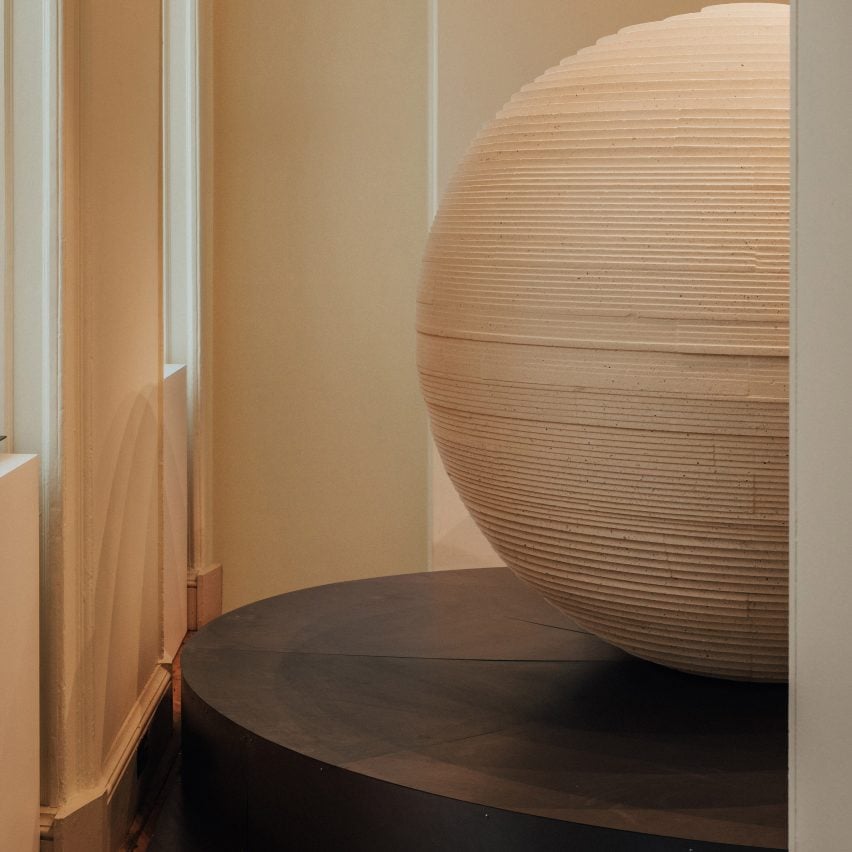The medal for this year’s best overall contribution to the London Design Biennale has gone to the Malta pavilion, which is presenting an expandable spherical urn designed to enshrine the ashes of multiple people together.
Called Urna, the project was commissioned by Arts Council Malta in response to the country’s landmark legalisation of cremation in 2019.
Traditionally, funerary urns house the ashes of a single person after they die. But Maltese architects Anthony Bonnici, Thomas Mifsud and Tanif Raif worked with local stone supplier Halmann Vella to create a monolithic urn that can be used to hold the ashes of an entire family.

“The idea has sparked a lot of controversy,” Bonnici told Dezeen at Somerset House, where the project is on display alongside works by more than 30 countries, cities, territories, organisations and individual designers as part of this year’s London Design Biennale.
“In Malta, a lot of us are born Catholic, but we don’t feel deeply connected to all the traditions and architecture around it, so we thought, why don’t we reimagine it all?”
In collaboration with local stone supplier Halmann Vella, the trio constructed the urn from stacked discs of poured Maltese limestone.

Adding new layers allows the vessel to grow and encompass more people.
“Urna is not a static monument,” considered Bonnici. “It’s something that grows over time, like the strata of the Maltese landscape.”
“It’s also a provocation to remove ego,” he added. “To not have this little photo and shitty little tombstone, and to be part of something a lot bigger.”
The architects will work on scaling up the Urna project over the next few years, with the aim of placing the urns in disused limestone quarries across the island that were abandoned after extensive mining.
“Essentially, it’s like a big fossil,” Bonnici said, likening the object to site-specific land art.
Malta spans 27 kilometres in length and 14 kilometres in width, but is among the world’s most densely populated islands, according to the Arts Council.

The project intends to create a sensitive but spatially compact solution to memorialising human remains on a small island.
“Urna is a remarkable contemplation of death and memory, a subject not often addressed through design,” said this year’s London Design Biennale jury, which included MoMA’s Paola Antonelli and the V&A‘s Christopher Turner.
“Their pavilion demonstrates a radical new way of thinking on a truly national level and we are delighted to award them the London Design Biennale medal.”

Meanwhile, the Polish pavilion received the medal for the most inspiring interpretation of this year’s theme and the Omani pavilion was awarded for best design.
Both are featured in our roundup of 10 standout pavilions to visit during the event. Dezeen also spoke to Samuel Ross, the biennale’s artistic director, about his thoughts on the current condition of British design ahead of the opening.
The photography is by Anne Immelé unless stated otherwise.
The 2025 London Design Biennale is on show at London’s Somerset House from 5-29 June 2025. For more information about events, exhibitions and talks, visit Dezeen Events Guide.
Project credits:
Project leads: Annabelle Stivala and Romina Delia
Architects: Anthony Bonnici, Thomas Mifsud and Tanil Raif
Curator: Andrew Borg Wirth
Art director: Matthew Attard Navarro
The post Collective urns designed to "remove ego" from funeral process appeared first on Dezeen.

